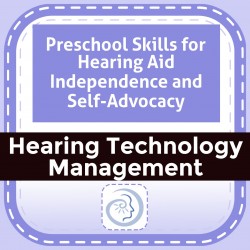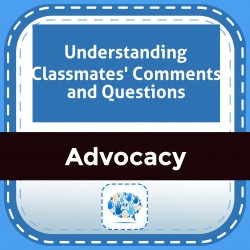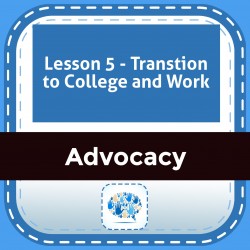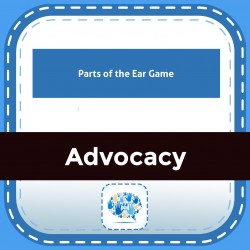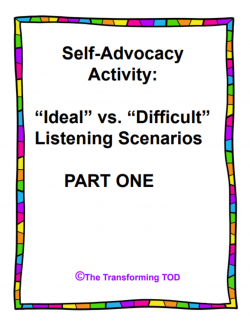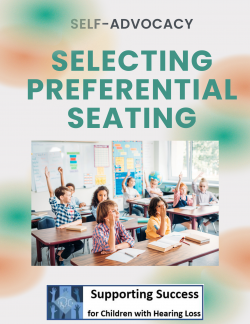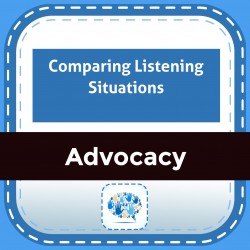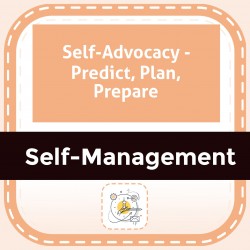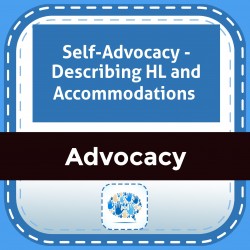Ability Levels
Categories
Resource Types
Age/Grade Range
CCSS
Anchor Standard
Speaking & Listening
Language
Reading
Preschool Skills for Hearing Aid Independence and Self-Advocacy
$ 195
Skill development is defined for preschool children prior to kindergarten. Chart specifies 7 skills and the roles of the preschool teacher, child and the DHH professional in achieving these goals. The
...
information describes how the Ling sound listening check should be performed in preschool.
Understanding Classmates' Comments and Questions
$ 195
Use these discussion questions and fillable planning guide to help students problem solve and learn to advocate for themselves when they do not have full access to a spoken message.
Lesson 5 - Transtion to College and Work
$ 0
Lesson 5 - Transitioning: Making the Move from High School to College and Work. This lesson provides definitions and examples of the concept of transitioning from high school to postsecondary placemen
...
ts and components of an Individualized Transition Plan (ITP). By Kris English.
Parts of the Ear Game
$ 5
This is a fun digital learning activity for a student to review the 3 parts of the ear. The learner identifies the function of each part, what is in each part and uses a diagram to identify parts of t
...
he ear.There are very few digital learning activities available today. Advocacy practice for students with hearing loss includes learning about hearing. As students begin to learn how they ear, identifying the 3 parts of the ear is a first step. They need lots of practice labeling different parts of the ear and identifying how they help with hearing. Learning Objective:1. The student will be able to identify functions of the 3 parts of the ear. 2. Given a diagram, the student will label the part of the ear.
"Ideal" vs. "Difficult" Listening Scenarios
$ 375
This resource contains 15 possible listening situations for DHH learners. Read each scenario and have your student decide if this is an "ideal" listening situation or a "difficult" listening situation
...
.
Self-Advocacy - Selecting Preferential Seating
$ 195
Do students know how to select a seat in different settings? Use this to plan activities for students to determine what is and is not a good place to sit in various situations.
Comparing Listening Situations
$ 5
This interactive Google Slides activity asks students to evaluate 4 listening situations (presented in pictures and short descriptions) and rate them on a scale according to listening difficulty. Afte
...
r rating the situations, students are tasked with providing an explanation of why each situation is difficult or easy to hear. This would be a great 'stepping off' activity to begin a unit on coping skills or to evaluate how a student perceives different situations and why/how he/she feels about his/her listening abilities.There is very little digital learning activities available for remote learning today. This tool that asks students to rate situations that are difficult or easy to hear encourages introspection about a student's hearing loss. Asking student to explain why the situation is easy or hard to hear encourages them to evaluate their own listening skills and how advocacy can improve even the most difficult situation.Learning Objective:The student will be able to compare listening situations by rating them on a scale from easy to hear to hear. The student will be able to describe why a specific listening situation is difficult or easy to hear, giving support for their answers.
Self-Advocacy - Predict, Plan, Prepare
$ 0
Making predictions and preparing for circumstances makes life so much easier. Help students understand how to manage time, problem-solve, and plan for their day with these ideas for activities and for
...
ward-thinking strategies.
Beyond the Sky’s Limit
$ 299
A collection of comic strips revealing troublesome situations for teens with hearing loss. Includes commentary on how each humorous situation might be resolved.20 more situations and scenarios that m
...
mix humor with compassion in negotiating social communication.More antics and advocacy for teens and tweens with hearing loss.
Self-Advocacy - Describing HL and Accommodations
$ 2
Fun ideas for role-playing activities with students to help them explain and advocate for what they need in order to communicate with peers and teachers.
 Your browser is out of date. For best experience switch to latest updated Browser.
Your browser is out of date. For best experience switch to latest updated Browser.
 Get Chrome
Get Chrome Get Edge
Get Edge Get Firefox
Get Firefox